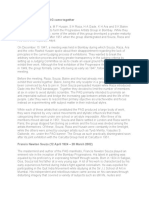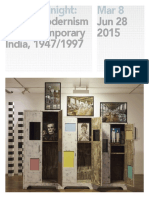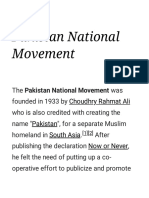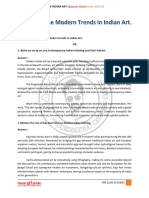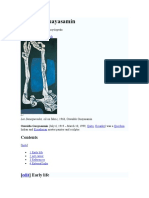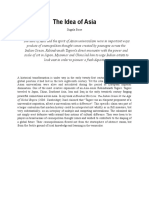Maqbool Fida Husain
Maqbool Fida Husain
Uploaded by
Komal JainCopyright:
Available Formats
Maqbool Fida Husain
Maqbool Fida Husain
Uploaded by
Komal JainCopyright
Available Formats
Share this document
Did you find this document useful?
Is this content inappropriate?
Copyright:
Available Formats
Maqbool Fida Husain
Maqbool Fida Husain
Uploaded by
Komal JainCopyright:
Available Formats
Maqbool Fida Husain, (born September 17, 1915, Pandharpur, India) popularly known as MF, is an artist of Indian
origin.
According to Forbes magazine, he has been called the "Picasso of India".[2] In 1996 controversy arose over paintings
originally painted in the 1970s which were interpreted as anti-Hindu. After legal cases and death threats in his home
country, he was on a self imposed exile from 2006. In January, 2010, he was offered the citizenship of Qatar, which he
accepted.
1940-1965
Husain first became well-known as an artist in the late 1940s. In 1947, he joined the Progressive Artists' Group, founded
by Francis Newton Souza. This was a clique of young artists who wished to break with the nationalist traditions
established by the Bengal school of art and to encourage an Indian avant-garde, engaged at an international level. In 1952,
his first solo exhibition was held at Zürich and over the next few years, his work was widely seen in Europe and the U.S.
In 1955, he was awarded the prestigious Padma Shree prize by the Government of India.[3]
[edit] 1965-1990
In 1967, he made his first film, Through the Eyes of a Painter. It was shown at the Berlin Film Festival and won a Golden
Bear.[4][5]
M. F. Husain was a special invitee along with Pablo Picasso at the Sao Paulo Biennial in 1971.[5] He has been awarded the
Padma Bhushan in 1973 and was nominated to the Rajya Sabha in 1986.[5] He was awarded the Padma Vibhushan in
1991.
[edit] 1990-present
Husain went on to become the highest paid painter in India. His single canvases have fetched up to $2 million at a recent
Christie's auction.[6]
He has also worked (produced & directed) on few movies, including Gaja Gamini (with his muse Madhuri Dixit who was
the subject of a series of his paintings which he signed Fida). The film was intended as a tribute to Ms. Dixit herself. [7] In
this film she can be seen portraying various forms and manifestations of womanhood including the muse of Kalidasa, the
Mona Lisa, a rebel, and musical euphoria. He went on to make Meenaxi: A Tale of Three Cities (with Tabu). His
autobiography is being made into a movie tentatively titled The Making of the Painter, starring Shreyas Talpade as the
young Husain.[8]
The Peabody Essex Museum (PEM) (USA, Massachusetts) showed a solo exhibition from 4 November 2006 to 3 June
2007. It exhibited Husain’s paintings inspired by the Hindu epic, Mahabharata.
At the age of 92 Husain was to be given the prestigious Raja Ravi Varma award by the government of Kerala.[9] The
announcement led to controversy in Kerala and some cultural organisations campaigned against the granting of the award
and petitioned the Kerala courts. Sabarimala spokesperson, Rahul Easwar, went to Kerala High Court and it granted an
interim order to stay the granting of the award until the petition had been disposed of. [10]
In early 2008, Husain’s Battle of Ganga and Jamuna: Mahabharata 12, a large diptych, from the Hindu epic, fetched $1.6
million, setting a world record at Christie's South Asian Modern and Contemporary Art sale
Mother India
In the February 6, 2006 issue, India Today, a national English weekly published an advertisement titled "Art For Mission
Kashmir". This advertisement contains a painting of Bharatmata (Mother India) as a nude woman posed across a map of
India with the names of Indian States on various parts of her body. The exhibition was organised by Nafisa Ali of Action
India (NGO) and Apparao Art Gallery.[22] Organizations like Hindu Jagruti Samiti and Vishva Hindu Parishad (VHP) have
protested persistently against Husain displaying the painting on the websites and even in exhibitions in north Europe. As a
result, on February 7, 2006 Husain apologised and promised to withdraw the painting from an auction. [23][24] The painting
later appeared on Husain's official website.
[edit] Meenaxi: A Tale of Three Cities
Husain's film Meenaxi: A Tale of Three Cities[25] was pulled out of movie theatres a day after some Muslim organisations
raised objections to one of the songs in it.[26] The All-India Ulema Council complained that the Qawwali song Noor-un-
Ala-Noor was blasphemous. It argued that the song contained words directly taken from the Quran. The council was
supported by Muslim organisations like the Milli Council, All-India Muslim Council, Raza Academy, Jamiat-ul-Ulema-e-
Hind and Jamat-e-Islami. Husain's son stated that the words were a phrase referring to divine beauty that were being sung
by the central character played by Tabu. He said there was no intention to offend. Following the wave of protests the
enraged artist pulled off his movie from the theaters. The movie was well received by the critics, however, and went on to
win various awards.
You might also like
- Modern Indian Art-01Document13 pagesModern Indian Art-01francy sharonNo ratings yet
- M. F HussainDocument7 pagesM. F HussainARPITNo ratings yet
- 2021 KAWS DidacticsDocument19 pages2021 KAWS DidacticsToño GarciaNo ratings yet
- M. F. HusainDocument6 pagesM. F. HusainJeff O'ConnellNo ratings yet
- Maqbool Fida HusainDocument3 pagesMaqbool Fida HusainsnehaoctNo ratings yet
- Art and ArtistDocument7 pagesArt and ArtistSHUBHAM ARORANo ratings yet
- De Personalities - M F HusainDocument6 pagesDe Personalities - M F HusainkarandiveshNo ratings yet
- Qatar Tribune - 4 Dec. 2008 - True Worshipper of ArtDocument1 pageQatar Tribune - 4 Dec. 2008 - True Worshipper of ArtSukanya S.No ratings yet
- Making History: How PAG Came TogetherDocument6 pagesMaking History: How PAG Came TogetherRohini ThakurNo ratings yet
- After Midnight - Brochure of Indian Art PDFDocument8 pagesAfter Midnight - Brochure of Indian Art PDFWaheedaBanoNo ratings yet
- Noor - Babri Masjid - Art PapersDocument8 pagesNoor - Babri Masjid - Art PapersTausif NoorNo ratings yet
- The Disordered Origins of Things The ArtDocument6 pagesThe Disordered Origins of Things The ArtSatishNo ratings yet
- Ustad Bismillah KhanDocument5 pagesUstad Bismillah KhanKirti JaiswalNo ratings yet
- A Brief Refractive Image of PAG - Bombay 1947 - Avik JanaDocument12 pagesA Brief Refractive Image of PAG - Bombay 1947 - Avik JanaAvik JanaNo ratings yet
- MF HusainDocument2 pagesMF HusainVarun ChatlaniNo ratings yet
- Indian Painting ArtDocument9 pagesIndian Painting ArtvovznpcwjvarnsgdxzNo ratings yet
- Kusumagraj (Poet)Document3 pagesKusumagraj (Poet)amol Akolkar ( amolpc86)No ratings yet
- Indian Artist S. H. Raza: Mohammad AshrafDocument30 pagesIndian Artist S. H. Raza: Mohammad AshrafShruti AgrawalNo ratings yet
- Abdur Rahman Chughtai - WikipediaDocument5 pagesAbdur Rahman Chughtai - WikipediaIrfan haiderNo ratings yet
- Famous Indian Paintings 1Document13 pagesFamous Indian Paintings 1vedikapatil252No ratings yet
- Depiction of Women in The Paintings of Pakistani Artist, Iqbal HussainDocument8 pagesDepiction of Women in The Paintings of Pakistani Artist, Iqbal HussainGlobal Research and Development ServicesNo ratings yet
- Bharat Mata (Painting)Document4 pagesBharat Mata (Painting)celsiusacademyNo ratings yet
- Indian ArtistDocument15 pagesIndian ArtistnonNo ratings yet
- Bismillah Khan: 2 CareerDocument5 pagesBismillah Khan: 2 CareerYogendra Kumar SahuNo ratings yet
- Assignment 4Document22 pagesAssignment 4K Sonali (RA1911004010158)No ratings yet
- Why Was MF Hussain Banished From IndiaDocument2 pagesWhy Was MF Hussain Banished From IndiaBabuKumarNo ratings yet
- Why Was MF Hussain Banished From IndiaDocument2 pagesWhy Was MF Hussain Banished From IndiaBabuKumarNo ratings yet
- PICASSO of Indian Art: PhilosophyDocument2 pagesPICASSO of Indian Art: PhilosophyManimegalai PrasannaNo ratings yet
- History 1Document5 pagesHistory 1phazeNo ratings yet
- Ethos VII CatalogueDocument24 pagesEthos VII Catalogueapi-246689622No ratings yet
- Hungry GenerationDocument2 pagesHungry GenerationArghya ChakrabortyNo ratings yet
- Parallel CinemaDocument4 pagesParallel CinemaRavichandraNo ratings yet
- Progressive Artist GroupDocument16 pagesProgressive Artist GroupVrindaNo ratings yet
- Indian Art FormDocument9 pagesIndian Art FormRashi Gambhir100% (1)
- 8-Article Text-136-1-10-20180626Document5 pages8-Article Text-136-1-10-20180626Shivalik DEPARTMENT OF GEOGRAPHYNo ratings yet
- Contemporary Indian Art & ArtistsDocument34 pagesContemporary Indian Art & ArtistsSahithiNo ratings yet
- Pandit Ravi ShankarDocument10 pagesPandit Ravi ShankarSumedha MM100% (1)
- Shastra Which Engaged With Iconography and Image-Making. in The Mid-19th Century There Was ADocument4 pagesShastra Which Engaged With Iconography and Image-Making. in The Mid-19th Century There Was AChandrika AcharyaNo ratings yet
- Culture and Mordernization in BarodaDocument39 pagesCulture and Mordernization in BarodaDharaniSKarthikNo ratings yet
- 1862 Mains Approach Answer E 2021Document21 pages1862 Mains Approach Answer E 2021kapil.choudharyNo ratings yet
- Calcutta Progressive Group (1943-53) : Modern Artists India KolkataDocument30 pagesCalcutta Progressive Group (1943-53) : Modern Artists India KolkataArushi AgarwalNo ratings yet
- Chapter - Ii History of Tamil CinemaDocument33 pagesChapter - Ii History of Tamil CinemaRebekah JulianneNo ratings yet
- Extra : Nandalal Bose and India's Freedom StruggleDocument4 pagesExtra : Nandalal Bose and India's Freedom StruggleMakrand ShirsatNo ratings yet
- Calcutta Group - WikipediaDocument9 pagesCalcutta Group - Wikipediachiranjitpattandar24No ratings yet
- Final Project MFDocument3 pagesFinal Project MFpriyanarain28No ratings yet
- Flower PowerDocument5 pagesFlower PowerEmdadul HaqueNo ratings yet
- Contribution of Indian Artist To National Freedom MovementDocument8 pagesContribution of Indian Artist To National Freedom MovementDivyata ChawlaNo ratings yet
- Mirwaiz Yusuf ShahDocument2 pagesMirwaiz Yusuf ShahNandu RaviNo ratings yet
- Bombay Progressive ArtistsDocument5 pagesBombay Progressive Artistslove_is_fun2000No ratings yet
- Pakistan National Movement - WikipediaDocument13 pagesPakistan National Movement - WikipediaRehana AmjadNo ratings yet
- Colonial PeriodDocument8 pagesColonial Periodfrancy sharonNo ratings yet
- Foment of The Moment: Even at Art Fairs Democracy Is Hard To Sweep Under The CarpetDocument5 pagesFoment of The Moment: Even at Art Fairs Democracy Is Hard To Sweep Under The CarpetKirk Chin HoNo ratings yet
- Indian PaintingDocument12 pagesIndian PaintingShubhranshu S. Saxena100% (1)
- The Modern Trends & PaintingDocument6 pagesThe Modern Trends & Paintingarchanashak1976No ratings yet
- Biography EnglishDocument3 pagesBiography EnglishKarina GarciaNo ratings yet
- Aarjsh: ISSN: 2278 - 859XDocument14 pagesAarjsh: ISSN: 2278 - 859XpratapNo ratings yet
- 12the Idea of AsiaDocument5 pages12the Idea of AsiaMaung Maung ThanNo ratings yet
- HJHJFDocument2 pagesHJHJFkhanif khanNo ratings yet
- M F HusainDocument3 pagesM F Husainajith0% (1)
- JETIR2202466Document5 pagesJETIR2202466Pankaj HarjaiNo ratings yet
- Meet Great Contemporary Iraqi Plastic ArtistsFrom EverandMeet Great Contemporary Iraqi Plastic ArtistsRating: 5 out of 5 stars5/5 (1)
- Barry's Project ObjectivesDocument8 pagesBarry's Project ObjectivesBarry MagrillNo ratings yet
- Pattern By: Tinna's Crochet Club On FB / Tinna@thorudottir On FBDocument17 pagesPattern By: Tinna's Crochet Club On FB / Tinna@thorudottir On FBLorena Melo AranedaNo ratings yet
- Appendix A - Quality ProcedureDocument2 pagesAppendix A - Quality ProcedureKhalid SulehriNo ratings yet
- Canberra GuideDocument30 pagesCanberra GuideEnnit78100% (3)
- South African Tropical ModernismDocument5 pagesSouth African Tropical ModernismJuliet BenningNo ratings yet
- Construction Material: TimberDocument32 pagesConstruction Material: TimberhamnahricoNo ratings yet
- English in ActionDocument32 pagesEnglish in ActionThy Vuong100% (1)
- Folk Arts and Crafts of MIMAROPADocument21 pagesFolk Arts and Crafts of MIMAROPAHazel Joie Alcaide NavarroNo ratings yet
- Esmeralda PendantDocument13 pagesEsmeralda PendantAnto Nella100% (4)
- Hard Bop and CoolDocument18 pagesHard Bop and CoolHasnainJamalNo ratings yet
- Leisure 2Document8 pagesLeisure 2Maria Garcia GuardaNo ratings yet
- Female Artists of Pakistan, and Impact of Their Work On Global Art SceneDocument13 pagesFemale Artists of Pakistan, and Impact of Their Work On Global Art SceneAJHSSR JournalNo ratings yet
- Archaeological S 04 e GypDocument138 pagesArchaeological S 04 e GypEgiptologia BrasileiraNo ratings yet
- Portfolio Evert DebusschereDocument36 pagesPortfolio Evert Debusschereevert debusschere100% (1)
- 12 Literary Insults To Make You Weep - BooksDocument17 pages12 Literary Insults To Make You Weep - BooksMattJHolmes100% (1)
- Beading A Mini-Medallion With Auntie AmberDocument8 pagesBeading A Mini-Medallion With Auntie AmberMMNo ratings yet
- III Assessment Grade 8Document4 pagesIII Assessment Grade 8Prayan SatraNo ratings yet
- Mold Cleaners LubricantsDocument3 pagesMold Cleaners LubricantsEliasNo ratings yet
- STEAM - Preschool Activities For STEM Enric - Jamie HandDocument92 pagesSTEAM - Preschool Activities For STEM Enric - Jamie HandMagdalena WeissNo ratings yet
- 1986 Perspective Anamorphosis and VisionDocument44 pages1986 Perspective Anamorphosis and VisionaujalanaveedNo ratings yet
- Military Modelcraft International July2016Document76 pagesMilitary Modelcraft International July2016Prplknite100% (4)
- Alphabet Project and Rubric 1Document2 pagesAlphabet Project and Rubric 1api-235556762No ratings yet
- Jobsheet Photoshop (Nor Amalina Binti Hood)Document6 pagesJobsheet Photoshop (Nor Amalina Binti Hood)Amel Pendek100% (1)
- Bulldog InstructionsDocument8 pagesBulldog InstructionsRaimundo Civera RedondoNo ratings yet
- Iso 4628 Part 1-Qty of DefectsDocument11 pagesIso 4628 Part 1-Qty of Defectsjasminnee100% (3)
- A.6 Coating System No. 6: Title: Coating and Painting Specification Rev.: Date: Doc. No.: 05-1 - EPC-SV-AEI-M-SA-00001Document1 pageA.6 Coating System No. 6: Title: Coating and Painting Specification Rev.: Date: Doc. No.: 05-1 - EPC-SV-AEI-M-SA-00001Tien Tran Kha TienNo ratings yet
- The Best Korean Drama of 2012 (The Preliminary Round) : Voting ResultsDocument3 pagesThe Best Korean Drama of 2012 (The Preliminary Round) : Voting ResultsAni AmbocheNo ratings yet
- Hats For CharityDocument38 pagesHats For Charitydecent_soldiers007100% (4)
- Visual AnalysisDocument5 pagesVisual Analysisapi-707494869No ratings yet








